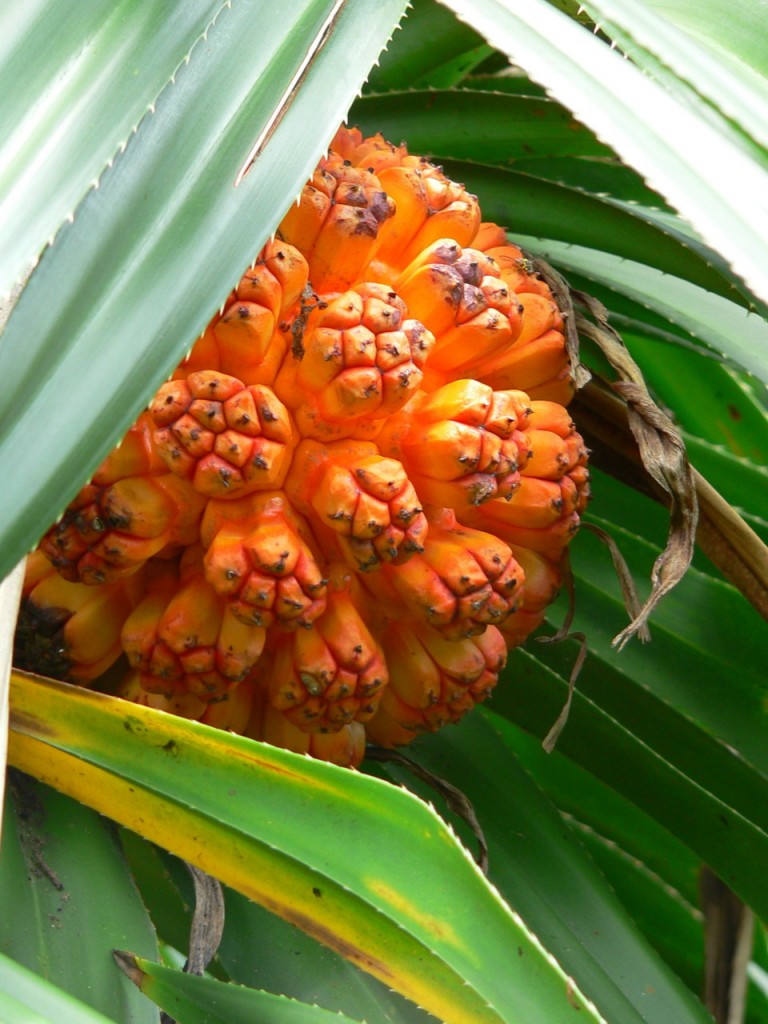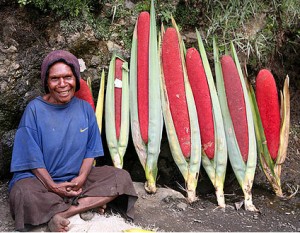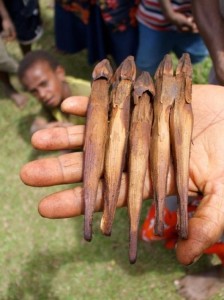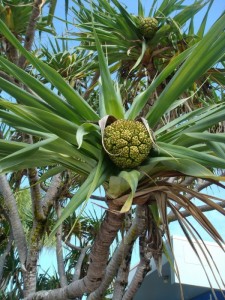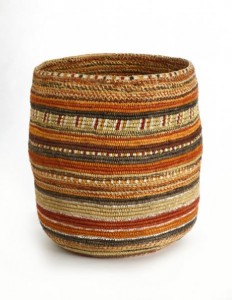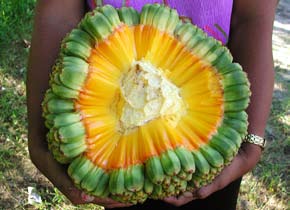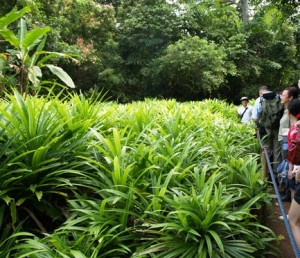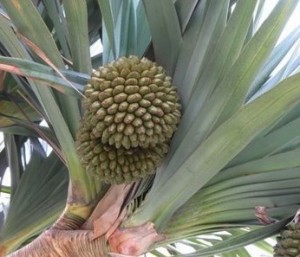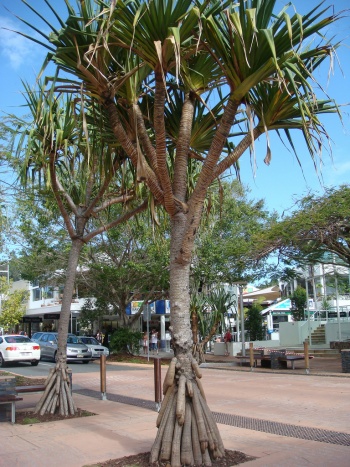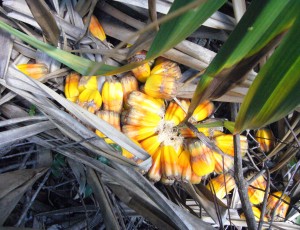During several visits over the course of a year it looked like a large berm of tall grass, about the size and height of a one-story house. For some reason it was trimmed back and began to fruit which led to its general identification: Pandanus. That naturally leads to a Pandanus problem: Which species is it?
The genus Pandanus has over 500 members and are found from West Africa eastward to Hawaii, from coastal areas up mountains to 10,000 feet, from species a few feet high to 10o-foot trees. There are many natural species of Pandanus and several cultivated varieties. They are and have been a major textile and food crop throughout the Pacific region and figure significantly in Polynesian culture.
Also called “Pandans” they fall into two large subgroups, those used for the fruit and those used for the seeds. Some fall in both groups. The ones with edible fruit and or seeds are usually either oily or consist mainly of carbohydrates. That group, generally known as “marita” is mainly Pandanus conoideus and perhaps Pandanus englerianus and Pandanus magnificus. Not every one agrees that the last two are separate species. The edible fruit is mostly red or yellow. Generally after processing it is used as a spread like butter. Another set in this subgroup is Pandanus tectorius which also includes Pandanus leram and the cultivated Pandanus fischerianus.
The second major food group of Pandanus produce edible seeds, some edible raw, some edible after proper cooking. The prime species for that is the ‘karuka’ of New Guinea, which can be either Pandanus brosimos or Pandanus julianettii. The seeds are oily, contain protein, and are on par with coconuts in their use and value. Some experts think all Pandanus species probably produce edible seeds but no one really knows. Trees begin to fruit between seven and eight years old and will produce for some 60 years. When they do fruit it takes two to six months for the fruit to ripen depending upon the species. Those used for the spread take two to three months to ripen, seed bearing ones four to six.
Besides carb or oil producing is there any other division we should be aware of? Yes. Wild versions can contain large amounts of calcium-oxalate crystals (raphides and rhomboids) which can irritate the mouth. Heating can break them down. In cultivated versions the raphides are reduced or missing so that some forms can be eaten raw. Minus the calcium oxalates Pandanus can be quite nutritional. The fruit flesh of the Pandanus tectorius, for example, contains per 100 gram of edible portion: water 80 g, protein 0.4 g, fat 0.3 g, carbohydrates 19 g, fibre 0.3 g. Oven-dried seeds of karuka (Pandanus brosimos) contain per 100 g edible portion: water 6—10 g, protein 8.5—14 g, fat 0.4—37 g, fibre 5—12 g, the remainder ash and carbohydrates. In those what is eaten is the terminal bud, or the growing end, like the heart of palm.
Pandans used for textiles include Pandanus dubius, Pandanus kaida, and Pandanus tectorius. Various products are made from them as bags, hats, pocketbooks, umbrellas mats, dolls even sails. Pandans did not escape the attention of the oldest still extant foraging group on earth, the Aboriginals of Australia. They used the top leaves for baskets, ate the fruit, and used dead trunks to carry fire with them, smouldering like an all-day, bat-sized cigarette. At least six species have been exported to warm areas of the world. Several species of Pandanus have been planted in Florida including Pandanus amaryllifolius, Pandanus baptistii, Pandanus sanderi, Pandanus tectorius, Pandanus utilius and Pandanus veitchii. Some Pandanus grow in Texas (definitely P. utilis) and many in Hawaii and Puerto Rico.
Among those in Florida Pandanus tectorius, aka Nicobar Breadfruit, is native to the seacoast from southern China to tropical Australia and Polynesia. Common in Hawaii, it’s a tree to 25 feet with spreading branches, numerous prop roots, and forms large, dense thickets. The leaves are evergreen, spirally set, strap-like to five feet long. Their edges are spiny and the leaves droop. The female flower is a single spike with a yellow spathe; male flowers are on a separate plant, very fragrant, composed of many dangling spikes in long, white spathes. The fruit is a globose, knobby head to ten inches long, orange-yellow, breaking apart when fully ripe, exposing soft edible pulp in the center. The terminal bud is also edible. Leaves are used for thatching and mats. The fleshy pulp of the fruit may be eaten raw, cooked, or made into flour, paste and thick flat cakes. Flour is often mixed with palm syrup or diluted with water to make a popular drink. Tender, white bases of the young leaves are eaten raw or cooked. Aerial roots are cooked and eaten or processed into beverage. Flowers and pollen are edible, too. Seeds can be made edible after processing. It’s also called Pandanus odoratissimus though that might just be a variation. Botanists can’t agree. Pandanus tectorius can withstand drought, strong winds, salt spray and propagates readily from seed or branch cuttings,
Pandanus amaryllifolius, uncommon in Florida, is the only species in the genus with fragrant leaves. It grows between 1.5 and 3 feet tall, sometimes to six feet. When older it produces aerial roots and stilt roots to support itself from falling. Leaves are slender, lush-green and smooth-edged up to 20 inches long. It resembles an amaryllis, hence the name. Leaves have a depressed center running from the base outwards gradually flatten towards the tip. Fragrant young leaves are cooked as a vegetable or used as a condiment. Fresh or dried leaves add a musty odor and flavor and green color to tofu, jellies, doughs, curries, syrups, sauces, coconut rice, and sweets. It is also added to cooking oil before cooking as a spice. The leave are used to wrap food such as rice dumplings. Sometimes called Pandanus latifolius. There is a bit of a schism with the Fragrant Pandan. Some insist the leaves are used only for flavoring and removed. Others insist young leaves can be cooked and eaten. As folk dancers say when they encounter a variation in a dance they know… “different village.”
Pandanus utilis, native to Madagascar, is a tree to 60 feet with stilt-like prop roots. Branches are few, sleek, rounded, tipped with clusters of evergreen, strap-like spiny leaves three feet long and three inches wide. Fruit is nearly round, six inches across, compound and rough surface, green, yellowing as it ripens with a small amount of edible pulp, numerous large seeds (which are sometimes called keys.) Leaves are used for matting and baskets. Fiber can be gotten from the roots for cordage and weaving thus the name “utilis” meaning useful. It is very slow growing from seeds or cuttings. Prop roots are also used as torches.
Pandanus baptistii is native to the South Sea islands. It’s herbaceous and dwarf with a short stem hidden by a clump of upright, arching, one-inch wide ribbon-like leaves. They are blue-green, striped yellow or white, smooth edge. Often grows in clumps. No edibility mentioned. Pandanus sanderi, native to East Indies and Timor, will not survive temperatures below 55 F thus it is usually a houseplant beyond the tropics. Also herbaceous, short stemmed and densely tufted with ribbon-like leaves 2.5 feet long with tiny spines on edges. They, too, alternate green and yellow from base to tip. Grows in clumps. No mention of edibility. Pandanus veitchii, native to Polynesia, to 40 feet, stilt-like prop roots, few branches, ending in huge clusters of strap-like leaves to eight feet long, three inches wide, bordered on both edges with a white strip, spiny margins and long-pointed tip. Non-fruiting in Florida. Usually a house plant. Leaves used for mats, screens, and lamp shades. Often a potted plant in northern climes. No mention of edibility.
Other Pandanus: Pandanus antaresensis, seeds. This species fruits continuously; Pandanus brosimos, West New Guinea, now West Irian Jaya, seeds are edible. Oven-dried seeds of P. brosimos contain per 100 g edible portion: water 6—10 g, protein 8.5—14 g, fat 0.4—37 g, fibre 5—12 g, the remainder consisting of ash and carbohydrates. The tree can grow to 100 feet tall. In Pandanus species that produce white seeds their flavor is similar to coconuts. Pandanus castaneus, oil; Pandanus conoideus, Papua, Indonesia, fruit is edible cooked, a red flavoring is also made from it; Pandanus dubius, southeast Asia, Pacific Islands, roundish seeds edible raw. Pandanus fascicularism, India, male flowers are the source of kewda attar, used for flavoring betel nuts, soft drinks, curries and an Indian rice dish called biryani; Pandanus foveolatus, seeds, fruits continuously; Pandanus galorei, seeds, fruits continuously; Pandanus houlettei, edible fruit; Pandanus Iwen, seeds; Pandanus leram, Nicobar Islands, the fruit is cooked for five to eight hours depend upon the state of ripeness. It is then pressed to separate a yellow paste from the fiber. The edible paste is used in a variety of ways, often as a spread like butter. Pandanus limbatus, seeds, fruits continuously but is the least preferred of all the Pandanus with edible seeds; Pandanus spiralis, Australia, fruit and seeds. The latter can be extracted from fruit and ground into flour and taste like a combination of peanuts and coconuts. There are 37 species found in Australia, usually along the coast of the northern territories.
While there are male and female trees P. brosimos, P. julianettii, and P. conoideus are believed to be parthenogenetic, read reproduce on their own. Fruiting for most Pandanus can also be a result of timing. Male flowers bloom every year. Female flowers every second year. And while male and female flowers may bloom at different times thus no fruit that year. The genus name, Pandanus, comes from the Indonesian name of the tree, Pandan. In English it is called Screw Pine because some species leaves appear to grow in spirals. Lastly, often the fruit is picked and just used for decoration.

